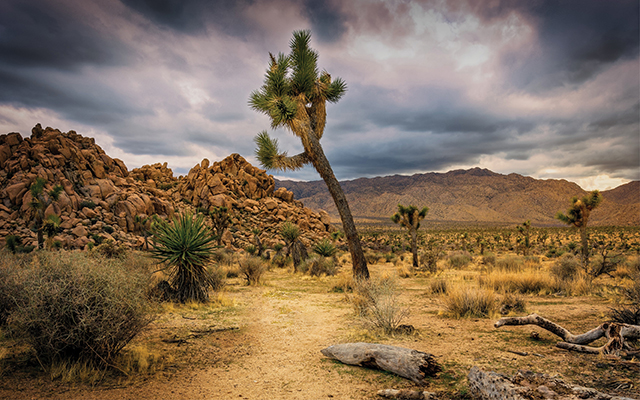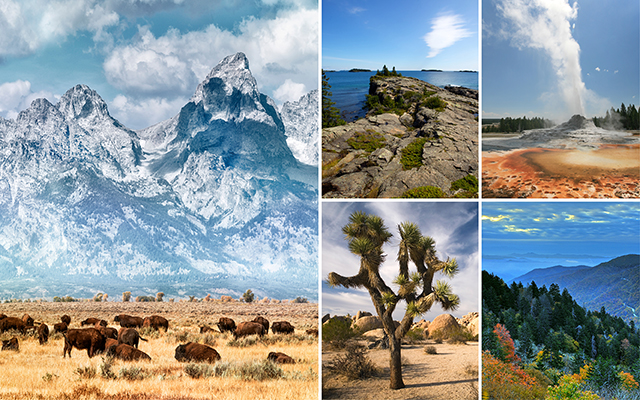The red neon sign for the Joshua Tree Saloon glowed against an impossibly dark night sky. I’d stepped out into the dirt parking lot with my cell phone pressed to my ear to hear the voice of the emergency-room doctor. My mom was in his care. “If it were me,” he said, “I’d come back tonight.” I packed my things and headed to the Los Angeles airport.
Listening to the doctor meant that I got to be at my mother’s side when she died. I was lucky. Much of the time I’m not such a good listener.
I’d been in the park only a few hours when I got that call, but it had been long enough to hike through a red-rock canyon at dusk, and for the sound of a crow’s wingbeat echoing between canyon walls to slice through my preoccupied thoughts. Growing up in the Midwest, I’d never spent time in the desert, and I was taken by the park’s stark beauty, how the silence there had a volume of its own. I couldn’t wait to return.
Joshua Tree National Park is located at the intersection of the Mojave and Colorado Deserts outside Los Angeles. It was proclaimed a monument in 1936, thanks to the tireless efforts of an alarmed heiress named Minerva Hoyt, who’d noticed visitors stealing the local flora and bringing it home to the city to landscape their yards. The Dr. Seuss-esque Joshua trees (Yucca brevi folia) are members of the agave family, and they’re monocotyledons, distant cousins to grasses and orchids. Their name comes from Mormon migrants who saw the trees’ gangly branches as arms reaching toward the sky in supplication, like Joshua in the Bible.
As with all desert occupants, Joshua trees are shockingly hardy — a mature specimen can survive on one good rainstorm every other year. But they’re also particular. They grow mostly at elevations between 1,300 and 6,000 feet, and according to National Park Service vegetation specialist Jane Rodgers, they require a hard frost in order to branch out from their trunks. (Some researchers suggest that the tree responds to frost damage at its tips by forming new limbs: injury may lead to growth.) They flower after good rains, although the amount and timing necessary are still unknown. Only the symbiotic yucca moth — and a few bird species, such as the cactus wren, whose numbers are in steep decline — can pollinate the blooms.
This balancing act has been maintained for at least 13,000 years, according to geologists who’ve identified Yucca brevifolia seeds in the ancient excrement of a long-extinct desert sloth. But climate change threatens it. As routine nighttime temperatures in the desert rise and drought intensifies, the trees don’t have the environmental conditions researchers believe they need to grow.
Cameron Barrows, an ecologist at University of California, Riverside, conducted a 20-year survey of the park that found a decline of young trees in 30 percent of their range. He speculates that by the end of this century, the range available to sustain the park’s tree population could be reduced by 90 percent. At that point, Joshua trees may exist only in isolated pockets at higher elevations, called refugia. Refuges.
Rock and Roll
I returned to the park last March, nearly four years after my first, curtailed visit. My intent was to hike in the monumental silence I remembered, and to acknowledge the anniversary of my mother’s death. I secretly hoped that being there again would allow me to connect with her, séance-style.
Given the park’s precarious situation, a better person would have been happy about the morning crowds in the visitors’ center. It was crawling with families, all clamoring to speak with a ranger about the best hikes. They were paying an entry fee, making memories, and becoming much more likely to protect this park and endangered lands in general.
That better person was my friend Jeannine, who pointed all this out when I grumbled. But I was panicky. I’d returned to Joshua Tree on a quest for quiet, and here were a lot of very chatty people threatening to get in my way.
Matters seemed to improve when we reached our first stop, Barker Dam. Built in 1902 as a watering hole for cattle, it’s now a rainfed reservoir enjoyed by bighorn sheep and other thirsty wildlife, found at the end of a half-mile hike past stark rock faces and gaggles of Joshua trees.
A tiny crested songbird perched on a cactus paddle and scrub jays swooped over the parking lot as we climbed out of the truck. The vibrating wingbeat of a crow echoed against the rocks, sounding just as I remembered.
But no farther than 50 yards down the path we got stuck behind an intrepid white-haired couple in sun visors climbing through a steep, narrow passage with trekking poles. Once past them, we discovered that the conversation of every hiker within 500 feet was amplified by the rock walls. It was like being at a party in a tiny apartment; we could hear their every word.
When we reached the dam, the water reflected the big, puffy clouds drifting across the sky. There were no bighorn sheep, but we saw elegant black pinacate beetles high-stepping through the sand and wood rats scurrying into their holes. The Joshua trees stood all around, looking goofy and indifferent. Yet I barely noticed any of it. I was too busy being annoyed by the people and their noisy voices.
This was not the path to silence I had imagined.
Quiet Riot
Determined not to be foiled twice, we studied the map once we were back at the truck and decided to head to Ryan Mountain. We assumed that the steep, three-mile loop to one of the highest elevations in the park would be less popular.
Au contraire. We pulled into the packed parking lot and waited several minutes for a spot to open.
Though we’d gone just a couple of miles from the dam, the topography was dramatically different. Stacks of smallish stones reached toward the sky like piles of broken crockery. We eyed the steep incline: The initial ascent involved a length of stairs that appeared to go straight up the mountainside. It wouldn’t be easy, but surely it would be quiet.
And it was, relatively speaking. As we huffed up the stairs and along the steep, narrow path around the side of the mountain, huge vistas opened before us. The San Bernardino range stretched out to the west, and the Cottonwood range to the south. More clouds formed and blew across the dome of the sky. Occasionally we’d encounter other hikers, which meant negotiating who would cross on the outside, nearer the steep drop-off, but the climb was largely free of other visitors’ conversations. Just the sound of the wind, the highway, airplanes.
And the sound of the endless anxious voice in my head. Should we turn back? Did we bring enough water? Isn’t there probably a better hike? Is this even safe?
That soundtrack never let up. Neither, it seemed, did the climb.
We eventually reached the peak despite my worries. The view was breathtaking: a panorama of three mountain ranges and the desert. A cool breeze dried our sweaty faces.
It was also the noisiest place on the mountain. Other visitors crowded around, taking pictures, chattering happily in multiple languages, delighted that they’d made it to the top. The voice in my head, having burned up some of its energy in the climb, managed to be quieted by the sublime view for a few seconds. And then that silence was broken by the snap of another selfie.
Rock Steady
Jumbo Rocks was our last stop. We parked near a campground where a group of climbers were scrambling up a giant boulder. By now I’d largely given up the quest for solitude.
This landscape looked more like a moonscape. Tall, smooth rocks loomed over the Joshua trees, casting long shadows in the late afternoon. We set out across the sand toward some big rocks and found a little canyon to hike through. It was suspiciously quiet, and I didn’t dare say anything, treasuring the few seconds of silence while I had them.
We’d climbed through the crevasse and were eyeing the next opening and wondering whether to tackle it, when a tan leg dangled into the space between rock and sky. Four teenage girls shimmied through, one by one. The last, in an unbelievable stroke, carried a little portable speaker. It transformed the silent canyon into a bumping dance club.
We could only laugh.
Backing out of the crevasse, we walked through the brush, following little paths among the creosote bush and cat’s claw. The sun was descending, and Jeannine hung back to take pictures while I jogged ahead.
I found a giant yellow rock facing west and climbed to the top. It felt like I was sitting on the back of an elephant. I listened to the breeze and the traffic on a distant highway. Finally, it was quiet. And I had just enough time before dark to make peace with the fact that I was not having the experience I’d expected to have.
My plan to come back to the desert and reconnect with my mother never really had a chance. The truth is, she never would’ve traveled here. She was a poolside, piña-colada kind of gal, not a dusty rock-scrambler.
I realized that what I was actually doing, thanks to some quiet, unconscious impulse in the back of my mind, was returning to the very place I had run to to escape the fact that she was dying. On both trips to Joshua Tree, I was trying to avoid the fact that I control little in this life, and instead was confronted by it. The desert put a microphone to my clutchy little fears. It gave me a chance to just listen to them, for once. And when I finally did, I wasn’t so afraid anymore.
Quiet (or quiet-ish) places like Joshua Tree National Park are worth our protection. Even with crowds, they showcase the beauty of resilience, how much life is possible even when conditions are hard. They demonstrate how we can grow from the places where we are injured. And they make it impossible to run from ourselves.
This originally appeared as “The Sounds of Silence” in the October 2018 print issue of Experience Life.



This Post Has 0 Comments